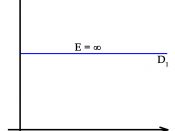Advertising Elasticity of Demand (AED)
The advertising elasticity of demand (AED) measures the responsiveness of changes in the quantity demanded to changes in the level of advertising. It is calculated using the following formula;% change in demand
% change in advertising expenditure
The calculation of the AED will produce a value. This value will indicate some of the characteristics of the good. For instance;稠value over 1 implies a relatively elastic demand. In other words, an increase in the level of advertising will cause a proportionately greater increase in the demand for the good. 稠value less than 1 implies a relatively inelastic demand. In other words, an increase in the level of advertising will cause a proportionately smaller increase in the demand for the good. The sign indicates how advertising influences the demand. For most goods, an increase in the level of advertising should cause the demand curve to shift to the right (D1 to D2).The
magnitude of the shift will depend on the value of the AED. For instance, if the AED is relatively elastic (greater than 1) then the change in the quantity demanded will be proportionately larger than the change in the level of advertising. The following is an example of how to calculate the AED:Original level of advertising = �0Original quantity = 50 unitsNew level of advertising = �0New quantity = 75 unitsIt is evident that a � increase in the level of advertising results in a 25 unit increase in the quantity demanded. The advertising elasticity of demand is% change in demand
% change in advertising expenditure
50%
20%
= + 2.5Therefore, the advertising elasticity of demand is 2.5, which is termed as relatively elastic. In other words, a 1% increase in the level of advertising will cause a 2.5% increase in the quantity...


